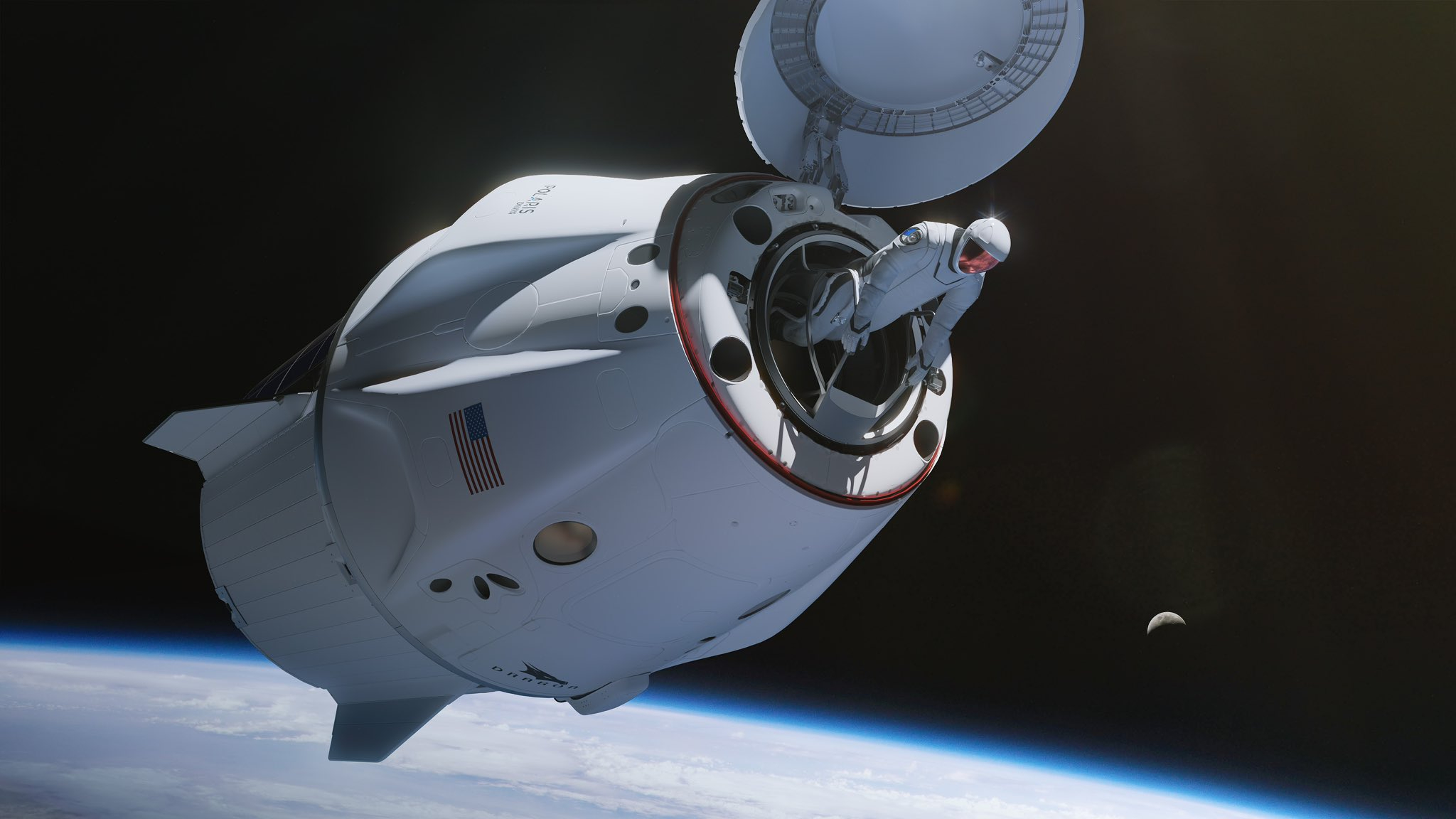How SpaceX modified a Dragon crew capsule for Polaris Dawn's historic private spacewalk

Polaris Dawn's spacecraft will be like no Dragon ever flown before.
The SpaceX Crew Dragon capsule for the Polaris Dawn mission sports modifications for the first-ever private spacewalk, which will take place after the scheduled launch on Aug. 27. Polaris Dawn's Dragon will also soar higher than any crewed spacecraft since the Apollo missions, flying above Earth at an altitude of about 435 miles (700 kilometers).
Read more below about the changes to Polaris Dawn's Dragon, which will carry four astronauts to orbit: billionaire funder and commander Jared Isaacman, who also flew, funded and commanded the Inspiration4 mission in September 2021; pilot Scott "Kidd" Poteet, a retired U.S. Air Force lieutenant colonel; and mission specialists Sarah Gillis and Anna Menon, both of whom are SpaceX engineers.
Dragon hatch and life support
Polaris Dawn's spacewalk will involve opening the Dragon's hatch, which has a new motor for the job — but the capsule won't feature an airlock. This is different than spacewalking procedures on the International Space Station and NASA's retired space shuttle, where the airlock has allowed the rest of the spacecraft to be isolated from the vacuum of space.
Dragon's lack of an airlock means all four Polaris Dawn astronauts will don their spacesuits during the spacewalk. The spaceflyers also cannot purge nitrogen from their systems and avoid decompression sickness by using pre-breathing procedures as seen on the ISS. Instead, the spacecraft will gradually lower its overall internal pressure while the partial pressure of oxygen rises, which will remove the nitrogen. Then all four astronauts will use pure oxygen in their suits while the spacewalk is happening.
"We're starting at about 14.5 psi (pounds per square inch) and going down to about 8.65 as the last stage of our pre-breathe, over a long period of time, to slowly pull nitrogen out of our body and reduce our risk of decompression sickness," Gillis explained in a press conference Monday (Aug. 19).
Breaking space news, the latest updates on rocket launches, skywatching events and more!
Starlink-equipped
Polaris Dawn will also feature a new communication system using laser links provided by SpaceX's Starlink broadband satellites, Isaacman explained in the press conference. "There is a laser that is mounted in the trunk of the vehicle that we will be flying on, and through beams of light, it will communicate to other Starlink satellites. This is pretty cool."
Isaacman said the laser communications will be difficult, as they'll involve Dragon and the Starlink craft moving independently of each other at 17,500 mph (nearly 28,200 kph), sending information from one spacecraft to Earth and then to the other spacecraft.
"It has the opportunity to open up an entirely new communication pathway, not just for Dragon, but for ... Starships or other satellites or telescopes out there," Isaacman said. (SpaceX's Starship is a next-generation spacecraft for heavy-lift missions, especially interplanetary ones.)
Starlink may at some point take on some of the communications duties for missions that normally use the U.S. Tracking and Data Relay Satellite System, used by ISS astronauts and the U.S. military, Isaacman suggested.
Spacewalk suits

SpaceX's new suit for spacewalks, or extravehicular activities (EVAs), has several changes to make it suitable for the vacuum of space. A new thermal management system, to keep the astronauts at a stable temperature, includes materials used in Dragon's trunk and in the interstage of SpaceX's Falcon 9 rocket, SpaceX has previously said.
The visor has a copper coating to protect against radiation, using tin oxide similar to that employed on the wraparound cupola window that flew on Inspiration4. Additionally, displays and cameras inside the helmet allow information to be displayed in front of the astronauts' eyes. Other changes include more flexible suit joints, an umbilical for life support and a new cooling knob to regulate internal temperature.
"Throughout there's all sorts of redundancy, both in the oxygen supply feed to the suit, as well as all of the valves and all of the seals across the suit," Gillis said in the press conference. "It's an incredible suit."
Mobility aids
Since spacewalking involves moving in an environment without friction, SpaceX has developed mobility aids to allow the astronauts to move around safely. Gillis said a "new structure" is available for gripping outside the Dragon's forward hatch.
Additionally, there are handholds and footholds inside and outside the spacecraft suitable for spacesuited astronauts. "We're just not going to be just floating around," Isaacman said.
He noted that the early Gemini program spacewalks of the 1960s allowed NASA astronauts to learn the correct procedures for spacewalking. After testing out devices like a hand-held maneuvering unit, NASA quickly realized that astronauts were prone to overheating without spacecraft handholds. In consultation with ground teams, astronaut Buzz Aldrin (who later landed on the moon with Apollo 11) demonstrated their effective use during spacewalks he undertook on Gemini 12 in November 1966.
"Be very deliberate with your movements. You want to make good use of mobility aids," Isaacman said of what NASA learned. "It was actually a lot of that pioneering work from Buzz Aldrin that set up a lot of future EVAs for success."

Elizabeth Howell (she/her), Ph.D., was a staff writer in the spaceflight channel between 2022 and 2024 specializing in Canadian space news. She was contributing writer for Space.com for 10 years from 2012 to 2024. Elizabeth's reporting includes multiple exclusives with the White House, leading world coverage about a lost-and-found space tomato on the International Space Station, witnessing five human spaceflight launches on two continents, flying parabolic, working inside a spacesuit, and participating in a simulated Mars mission. Her latest book, "Why Am I Taller?" (ECW Press, 2022) is co-written with astronaut Dave Williams.



